Jul-08-19
 | | KEG: This victory by von Scheve over Schlechter was a major upset that had important consequences for this tournament and perhaps for the history of chess. This game was played in the first round of the Monte Carlo 1901 tournament. Going into this event, Schlechter had just tied for first with Pillsbury at Munich 1900. A fine result that indicated that Schlechter had become one of the chess elite and a possible challenger for the world's championship. von Scheve, by contrast, had (to put it mildly) an undistinguished career going into the Monte Carlo 1901 tournament. In Frankfor 1887, he finished in a tie for 17th place (out of 21). At Manchester 1890, his best result before Monte Carlo 1901, von Scheve had finished in a tie for 7th to 9th places (Tarrash being first). And at Leipzig 1894 (also won by Tarrasch), von Scheve finished in 18th (last) place. He apparently had played no tournaments for seven years going into Monte Carlo 1901. Thus, he was very much an underdog against Schlechter (playing White!0 in this game. As a result of this win, Schlechter finished 3/4ths of a point behind Janowski (under the strange scoring system used at Monte Carlo 1901. Had Schlechter won this game, he might well have won the event, and with two straight major wins might have been a plausible challenger. As it was, his second behind Janowski made it difficult for him to claim he was a plausible challenger for another nine years. Meanwhile, thanks in large part to this win, von Scheve finished in a tie for 3rd with Tchigorin ahead of Alapin, Mieses, Blackburne, Gunsbert, Marco, Marshall and other. This tournament was to be the high point of von Scheve's career. He finished 17th out of 20 at Monte Carlo 1902 (losing his game against Schlechter) and then disappeared from chess history. The game itself is a bit of an enigma. Pressing too hard for a win, Schlechter got into trouble. He was seemingly dead lost by move 40, and soon thereafter found himself two pawns down in a seemingly hopeless position. He nonetheless played on, and watched von Scheve miss numerous chances to end the contest. Then, on move 63, Schlechter set a trap which should not have worked against even a beginner. With 63...Kg5?? (if the score is to be believed), von Scheve fell head-first into the trap, turning a clear win into an immediate loss. Yet, Schlechter immediately blundered with 64. Kg2!!, turning a simple win into a hopelessly lost position. Not only was this possibility apparently missed by both players during the game, but the commentary in the Tournament Book by Schlechter and von Scheve ("S/S") makes no mention of the astonishing back-to-back blunders on moves 63 and 64. This is all hard to believe, but the tournament book, this site, and my book on Schlechter all have the same game score. For purposes of my kibitzing here, I will assume the score is correct. But, having played over and analyzed many of Schlechter's game, I still don't believe it. 1. d4 d5
2. c4 e6
3. Nc3 Nf6
4. Nfe c6
Adopting a Semi-Slav formation. In this regard, von Schebe was years ahead of the tide. 5. e3 Bd6
The more usual 5...Nbd7 is almost certainly better (since it gives Black more options). The lines, however, can easily transpose. 6. Bd3 Nbd7
7. e4
"!"--(S/S)
"If 7. 0-0 Black could reply 7...e5" (S/S) But in this line, 7...dcx4 and 7...0-0 would be better (though White would still have the superior game), and if 7...e5, White would definitely be better after 8. dxc5. The above being said, I agree with S/S that 7. e4 is probably best here for White. 7... dxe4
8. Nxe4 NxN
9. NxN Nf6
10. Bc2 b6
11. 0-0 Bb7
12. Qe2 Qc7

click for larger viewWhite (Schlechter) had emerged from the reasonably well-played opening with somewhat better chances. The spectators (and no doubt the players themselves) no doubt expected that Schlechter would win. There was as yet no signs of the many surprising developments about to occur. |
|
Jul-08-19
 | | KEG: Post II
13. Bd2
Not bad, but 13. Rd1 or 13. Be3 would have superior ways to try to capitalize on his small positional advantage. Alternatively, if he was worried about von Scheve developing a King-side attack, he could have played the prophylactic 13. h3. The text looks toward positing the Bishop on c3; a questionable plan. 13... c5!
von Scheve had come to play and was apparently not prepared to sit still and watch Schlechter build up one of his slow positional crushes. 14. Bc3
Schlechter and von Scheve, in their commentary on this game (S/S)for the Tournament Book call this move "best." They discuss the supposed alternative, 14. d5. While 14. d5 would indeed be a premature and poor choice and as it hands the edge to Black, the S/S analysis was badly flawed: 14. d5 0-0 (very weak--Black would have a fine--and probably superior--position after 14...-0-0-0--KEG) 15. dxe6 [another bad suggestion by S/S--14. Bc3 would give White what he presumably craved in played 13. Bd2--KEG] Rae8 16. exf7+ [awful--KEG--White would still have a playable game after 16. Bf5 or perhaps 16. Qd3 rather than S/S's move] Qxf7 (needlessly relinquishing his threats on the b8-h diagonal [16...Rxf7 gives Black the better--and perhaps a winning game]. Even after 16...Qxf7, Black would have the better chances, but only because of the bad 16th moves chosen for White by S/S. Best play for White was 14. Ba4+ after which von Scheve would have had to play the ugly 14...Kf8 to avoid getting into trouble (14...Nd7 15. dxc5 bxc5 16. Rad1 leaves Black with a tough defensive task to survive--exactly the sort of position in which Schlechter at Munich 1900 made a habit of overwhelming his opposition. 14... cxd4
15. Bxd4
15. Ba4 was still a good try for White.
After 15. Bxd4, the position was:

click for larger viewvon Scheve was clearly itching for a King-side attack. And as will be seen, this prospect began to cloud Schlechter's usually excellent judgment. But, as von Scheve obviously recognized, the immediate 15...BxN 16. QxB Bxh2+? [16...0-0-0 was best in this line] would lose to 17. Kh1 since White now wins the intruding Bishop since his Rook on a8 is hanging. von Scheve avoided this little pitfall, but missed his chance to get the better game: 15... Nh5
Focusing on his longed-for King=side attack, von Scheve missed 15...Rc8. 16. Be4
Schlechter should have put an end to von Scheve's dreams of attack on the b8..h2 diagonal with 16. Be5!. 16... Nf4
"!"--(S/S)

click for larger viewThe simple and immediate 16...0-0 was a good alternative. 17. Qe3 BxB
18. QxB 0-0
19. b3
Schlechter should perhaps have put an end to von Scheve's King=side plans with 19. g3 19... Rfe8

click for larger viewTo this point, the game had been closely contested and chances were about equal (perhaps Schlechter was a tad better). Beginning in this position, however, Schlechter and spent the rest of the game fighting for survival |
|
Jul-09-19
 | | KEG: Post III
What I meant to say at the end of my last post was: "Beginning in this position, Schlechter erred and spent the rest of the game fighting for survival." 20. Ne5?
"?"--(Schlechter/von Scheve ["S/S"])
"This move appears good, but Black finds an effective response." (S/S) Schlechter could have retained a tiny edge with 20. Be5. The text, however, allowed von Scheve to drive the White Knight back and then begin a powerful pawn steamroller in the center. Schlechter may or may not have been theoretically lost after this error, but he was certainly in trouble. Schlechter should have played 20. Be5.
20... f6!
21. Nf3
21. Nd3 would have been even worse for White (e.g., 21. Nd3 f5 22. Qe3 NxN 23. QxN Rd8 (or 23...Bxh2+ first). Had Schlechter played 20. Be5, he would have spared himself the grief he now faced. 21... e5!
21...f5 first would also have been good.
A glance at the board reveals how badly Schlechter's position had deteriorated because of 20. Ne5: 
click for larger view22. Bb2
Schlechter plays much of the rest of the game as if in shock, and without the positional calm and grit he displayed at Munich 1900. Here, 22. Bc3 was more flexible and better. 22... f5!
The steamroller presses on.
23. Qc2

click for larger view23... Re6?
"23...e4 was very strong." (S/S)
After 23...e4!, Schlechter would have been hard-pressed to save the game,e.g., 24. Ne1 e3 leaving White in a position I would not care to defend. The text gave Schlechter a respite that should have allowed him to organize an effective defense and save the game. 24. Bc1 Nh5
Missing another chance to play 24...e4. Amazingly enough, von Scheve didn't get around to playing e4 until move 40, giving Schlechter plenty of time to set his house in order (though Schlechter, who played the balance of this game in what looks to be a fog, failed to take advantage of von Scheve's lapses). If he didn't fancy 24...e4 here (though that was best), von Scheve could still have kept his foot on the accelerator with 24...Ng6. 25. Qd1
25. Qe2 was better. Schlechter perhaps was hoping to organize a counter-attack with Qd5, but von Scheve's next move put a stop to any such fantasies. 25... Nf6
"He was threatened with Ng5 and Qd5" (S/S).
26. h3
Missing the chance to defend with 26. g3.
26... Bc5

click for larger viewAt first glance, 26...Bc5 looks great. But here Schlechter had a clever combination that would have saved the day. Schlechter missed this combo, and S/S did not mention the possibility. I missed it too when playing over the game, but when I fed the position to Fritz and Stockfish, my silicone friends found the solution in a nano-second. |
|
Jul-10-19
 | | KEG: Post IV
After 26...Bc5, Schlechter could have cured most of his woes with the remarkable 27. b4! A likely continuation would have been 27...Bxb4 28. c5! Bxc5 29. Qb3 Qc6 (or 29...Rfe8) 30. Ng5 picking up the exchange for two pawns and obtaining approximately equal chances. von Scheve could have avoided all this with 26...Rd8 or 26...Ree8. But after 26...Bc5, Schlechter missed his chance with: 27. Bb2?
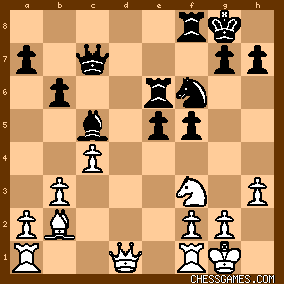
click for larger viewNow, von Scheve was very much back on top. And things immediately got even worse for Schlechter: 27... Rd8
28. Qc2?
Only time trouble can explain such a weak move by so strong a player as Schlechter. In order to have any chance, Schlechter had to play 28. Qe2 or Qe1 and then answer 28...e4 with 29. b4. Schlechter might nevertheless have still been lost. But after the text, von Scheve should have run him off the board. The position after 28. Qc2? was:

click for larger view28... Ne4?
For much of this game, von Scheve seemed allergic to playing e4. Here, 28...e4 (getting the steamroller going again) should have allowed von Scheve to win. The text was worse than useless. Not only did von Scheve play 28...e4, he put his Knight on e4 thereby blocking his own pawn from moving forward. Incredible! After 28...Ne4? any advantage von Scheve had enjoyed was gone. Schlechter was now very much back in the game, and--being much the stronger player--had every reason to be optimistic about his chances to win. 29. Rad1 Rde8
30. Rd5 h6

click for larger viewThe move 30 time control had now passed, so time trouble should not have been a factor for at least a while. Nonetheless, Schlechter quickly dug another hole for himself: 31. a3
Preparing b4 and looking to stymie von Scheve on the Queenside. But his plan was obvious and von Scheve could easily parry the "threat." 31. a4, locking up the Queen's wing looks better (though the logic of depriving Black's Bishop room to maneuver had a certain logic. Another interesting possibility was 31. Nh4 31... a5
Now b4 would lose a pawn [as it did two moves later]. 32. Ne1?
Hard to believe Schlechter played White in this game. The text--even if not leading to immediate loss, was terrible. Schlechter had an embarrassment of plausible moves here: e.g., 32. a4' 32. Qb1; 32. Rdd1; 32. Bc1; 32. Nh4. After 32. Ne1?, the position wasa:
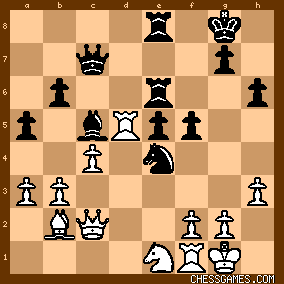
click for larger view |
|
Jul-11-19
 | | KEG: Post V
32... Nf6
"!"--(S/S)
S/S point out that the tempting 32...Ng3 loses. They give the following neat variation: 33. RxB! QxR [33...bxR 34. fxN e4 35. Rxf5 Qxg3 36. Bc3 is not quite as bad for Black, but also loses--KEG] 34. Nd3 "followed by 35. fxN [35. c5! is even stronger for White--KEG] 33. b4!
"The only chance." (S/S)
"If 33. Rd1 e4 with a totally superior position." (S/S) 33... axb4
34. axb4

click for larger view34... Bxb4
Stronger for Black here is 34...Bd4! after which Black nabs the Rook (e.g., if then 35. BxB exB White has no time for 35. Rb5 since his e1 Knight is hanging). 35. Rb5!
35. Rd1 would run into 35...e4 (assuming that von Scheve was finally ready to play this move--to which he previously seemed allergic) 35... Bf8
36. Qxf5 Qxc4
He could also have played 36...e4 immediately.
After 36...Qxc4 the position was:

click for larger view37. Qd3
S/S said that 37. Rxe5 RxR 38. BxR would be bad for White because "the Bishop is vulnerable and the attack continues." But this does restore material equality and seems to leave Schlechter with a defensible, even if still somewhat inferior game, e.g., 38...Qd5 39. f4 b5 40. Nf3; or 38...Qe4 39. QxQ NxQ 40. Nd3. 37... Qc7
"!"--(S/S)
S/S go on to say that if 37...QxQ 38. NxQ e4 39. Nf4 "Black's winning chances are reduced." I agree that 37...QxQ was not best, but the line S/S suggest looks more promising for Black than the position following the text move. Best was 37...Qc6, keeping White under pressure on both sides of the board. 38. Qb3
This temporary pin of the Black Rook accomplishes little. Best was 38. Qe2. 38... Kh8
39. Nf3 Bc5

click for larger view40. Re1?
This should have been the losing move (had von Scheve followed up properly). 40. Ba3 was essential. 40... e4!
Finally!
41. Nd4 Re5?
Both 41...Rd6 and 41...e3 were very strong here, and Schlechter looks dead after either of these moves. After 41...Re5?, however, he had real chances (which he quickly squandered as I will discuss in my next post on this game). The position after 41...Re5 was:
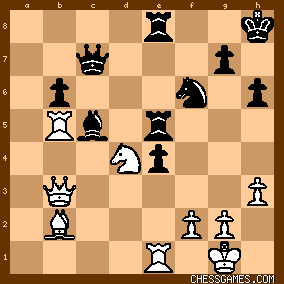
click for larger view |
|
Jul-11-19
 | | KEG: Post VI
42. Nc2?
"?"--(S/S)
"An oversight which costs a second pawn" (S/S)
42. Ne2 was seemingly the only chance. After the text, von Scheve won a second pawn and simplified to an ending that should have been easily won (though von Scheve made heavy weather of the ending and nearly lost). 42... Bxf2+ !
"!"--(S/S)
43. KxB RxR
44. QxR QxN+

click for larger view45. Re2?
This was the last move before the second time control, so perhaps Schlechter was in time trouble. If not, I am surprised he did not play tougher defense with 45. Kg1. 45... e3+
With 45...Qc5+, von Scheve could have gotten the Queens off the board, after which Schlechter would probably have had to reduce to a Rook and Pawn ending two pawns down: e.g., 45...Qc5+ 46. QxQ bxQ 47. BxN gxB. von Scheve should have been able to win this ending and avoid tactical tricks (always a reasonable option over the board when facing a much stronger player). The text--a least theoretically--looks better than just playing to simplify. But the real killer here was 45...Qb1! 46. Kg1 Qd1+
47. Kh2 Qd6+
48. Kg1?
Schlechter appears to be resigned to defeat from this point on. 48. g3 would have made von Scheve's task more difficult. 48... Re4
Even stronger was 48...Qd5.
49. Qf5?
Tantamount to resignation. 49. Qb3 was much better. Indeed, even 49. BxN was superior to the text. 49... Qd1+
The game now definitely looked over:

click for larger view50. Kh2?
Schlechter obviously needed to play 50. Qf1 here, though this would have allowed von Scheve to trade Queens and reach a very easily won ending. The text hangs a Rook: 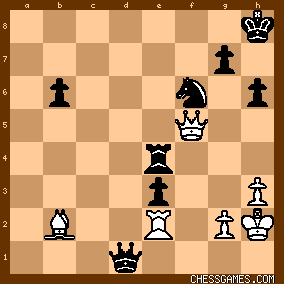
click for larger viewIt would be ridiculous to give this as a problem: Black to move and win, since the answer was the really obvious 50...QxR. Apparently, Schlechter and von Scheve--both over the board and in their commentary on the game, overlooked the fact that White can not avoid losing a Rook (after 50...QxR) via 51. BxN gxB 52. QxR because Black has the not very hard to find intermediate move 5...Qc4! Well, everyone missed this, since von Scheve responded 50...Qd7?, and no comment appears in the S/S analysis appearing in the Tournament Book. 50... Qd7?
And the game went on, the position now being:

click for larger viewSad to say, the worst was still to come. |
|
Jul-11-19
 | | KEG: Post VII
I am pained by this poor effort by Schlechter because I greatly admire him and because it is not typical of his play. At his last tournament before Monte Carlo 1901, Schlechter had gone undefeated and tied for first with Pillsbury and Maroczy, and tied the tie-break match for first place with Pillsbury. Of all the players who NEVER became World Champions, I rank Schlechter in the top 10 or 11. The first rank in this elite group consists of Keres and Korchnoi (the two greatest non-World Champions in chess history). In my second tier I place Tarrasch, Pillsbury, Rubinstein, and Caruana. In the third tier (places 7-11 in my personal pantheon) are--in no particular order: Reshevsky, Fine, Bronstein, Stein, and Schlechter. To see a player of this caliber fumble his way through his opening round game against von Scheve thus saddens me: Anyway, back to the game:
51. Qf3
Another poor move. 51. Qg6 or 51. QxQ were better (though Schlechter was almost certainly lost anyway). 51... Qe6
52. g3
To support his intended h4, but clearly inferior to 52. Bc1 or 52. Qg3. 52... Kh7
53. BxN?
Why on earth did Schlechter trade his strong Bishop for von Scheve's Knight. 53... gxB

click for larger viewSchlechter's game was plainly in the last throes at this point. Queen and Rook endings are tricky, but Schlechter was two pawns down and von Scheve had a dangerous passed b-pawn and an even more dangerous pawn on e3. 54. h4?
Continuing with his misguided plan. Schlechter sole realistic hope was to play 54. Qh1 or 54. Qf1 and then swing his Queen over to the Queen side and try to penetrate. When Schlechter finally got around to trying this approach beginning two moves later, he nearly swung the game in his favor (with a little help from von scheve). 54... f5
Useful, but he should have started his passed pawn rolling with 54...b5. 55. Kg2?
More uncharacteristic dithering by Schlechter. He should either have tried to penetrate with his Queen beginning with 55. Qh1 or have tried to tie up von Scheve on the King-side with 55. h5. 55... b5!
At last1

click for larger view56. Qf1
Finally trying to get his Queen to penetrate by sliding across his first-rank and then attacking. I see no better plan. 56... b4
57. Qa1?!
Going whole hog for the gold. This was probably not best, but Schlechter seemingly had decided to bring the game to a climax. If that was indeed his idea, he succeeded beyond anything he could have imagined. 57. Re1 was one try. 57... b3?!
Taking no prisoners and almost certainly good enough to win. But he might have tried to anticipate Schlechter's attack with 57...Kg6 or 57...Qd5. After 57...b3?!, the battle lines were drawn:

click for larger view |
|
Jul-12-19
 | | KEG: Post VIII
58. Qa7+?!
Pushing his counterattack plan to extremes. He had many alternative options (e.g., 58. Re1; 58. h5; etc.), but decided to press on heedless of the risk. His hope that his temerity would induce von Scheve to err was soon to come to fruition. 58... Qe7
58...Kg6 was simpler and better, but the text did not really spoil anything. 59. Qa5 Qd7

click for larger view60. Qb6?
Schlechter's position was so far underwater at this point that any criticism of his play may be out of line. But the text should have allowed von Scheve to wrap up the game immediately. 60... Qe6?
While the game was still a clear win for Black even after this lemon, 60...f4! would have been crushing and should end the game (e.g., 60...f4! 61. Re1 f3+! 62. Kxf3 Qd5 after which White cannot even give a check in light of the discovered attack on the Queen [63. Qc7+ Re7+ winning the White Queen and with mate to follow soon]). Another problem with the text is that it clears the 7th rank for White to check the Black king--a chance Schlechter quickly seized. 61. Qb7+?!
Further madness, but this--as will be seen--was probably Schlechter's only practical chance. 61... Kg6!
Well played. Schlechter has no more checks, and the game looked to be over. But stay tuned: 
click for larger view62. Kh2 Re5
62...Qc4 was simpler, but the text should not have imperiled Black's win. 63. h5+?!
Say what you like about this move, it gave von Scheve a chance to blunder. Not much of a chance, mind you, but what else could Schlechter have done. The position after 63. h5+?! was:
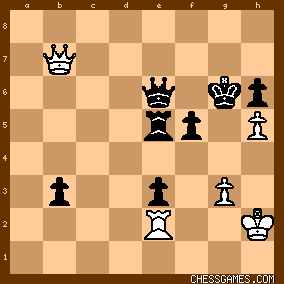
click for larger viewHow's this for a problem: Black to move and lose. 63... Kg5???
This will do it. With this one move, von Scheve went from an easy win (he could, after all, have simply played 63...Kxh5, the most obvious move on the board) to what should have been an immediate loss: 
click for larger viewNew problem, (and this one is not very difficult): White to move and win. 64. Kg2???
64. Qg7+ Kxh5 65. Kg1! (and Black has no answer for the coming 66. Rh2). The text, by contrast, allowed von Scheve to finish off Schlechter in short order. Incredible that the Tournament Book made no comment on either 63...Kg5??? or 64. Kg2??? The commentary on this game, as previously mentioned, was by the players ("S/S"). Thus, Schlechter and von Scheve missed the boat here both during play and in writing up their commentary. 64... Rc5
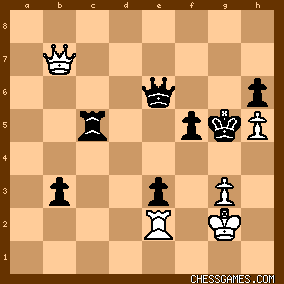
click for larger viewNow the game was over. |
|
Jul-12-19
 | | KEG: Post IX
65. Qb4
Tantamount to resignation.
65... Qc4
65...Qe4+ was an even easier way to win: 66. QxQ fxq 67. Rxe3 Rc2+ followed by 68...b2. But the text also closed proceedings quickly, the position now being: 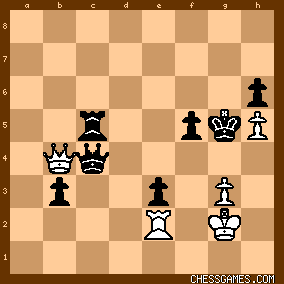
click for larger view66. QxQ RxQ
67. Rxe3

click for larger viewSo Schlechter had (very temporarily) won back one of the pawns he had lost, but there was now nothing left to play for. 67... Rb4
68. Re1 b2

click for larger view0-1
If 69. Rb1 Black cleans up with 69...Kxh5 70. Kf3 Kg5 after which Black's King penetrates and picks up White's g3 pawn. Resignation was not premature. |
|
|
|
|





